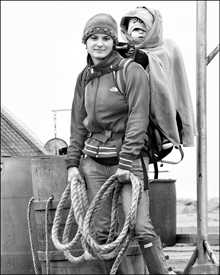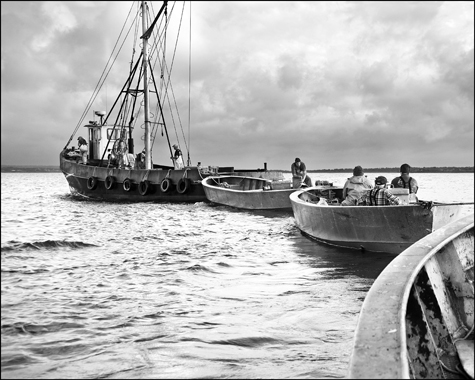The seafaring life
By GREG COOK | June 5, 2012

KEEPING IT IN THE FAMILY A portrait of a mother and her daughter. |
Living here near the coast, commercial fishing is never far away, but it can seem otherworldly, like an old romantic myth that surprisingly turns out to still be true. That romance of men working with their hands, grappling with the elements to feed society, is at the heart of Markham Starr's exhibit "In History's Wake: Trap Fishing in Rhode Island" at the Museum of Work and Culture (42 South Main Street, Woonsocket, through June 15).Starr, who is based in North Stonington, Connecticut, spent the summer of 2008 photographing the last trap four fishing boats in Rhode Island — two out of Point Judith, two out of Sakonnet. So the photos are not just about the beauty of the sea and sky, the roughneck steel-hulled vessels bristling with gear, and the weathered hands mending torn nets; they also speak of the romance of an endangered way of life. "There used to be literally hundreds and hundreds of them," Starr says of the trap fishing boats, "and thousands of people employed."
Trap fishing uses a system of floating fish weirs, with netting set up like fencing running some 1500 feet out from the shore suspended between anchors along the sea bottom and floats on the water surface. The nets funnel fish into a roughly 80-foot-long box-shaped trap.

AN ENDANGERED WAY OF LIFE Fishermen heading to the traps. |
"The images hint at the difficult economic and environmental issues such as vying for portions of the Atlantic to fish and contenting with maritime regulations that put this industry at risk of disappearing altogether," a sign introducing the exhibit reads. It's a curiously anti-regulatory (anti-environmental?) statement considering that the story of commercial fishing, particularly over the past century, is how improved skill and technology (steel-hulled power boats eased offshore fishing; electronic scanners aided fish tracking) have made fleets so good at catching fish that they've often dangerously depleted the stocks their livelihoods depend on. Government regulations — though often imperfect — have attempted to balance maintaining fishermen's livelihoods while sustaining stocks of fish.
But that commentary isn't really in the photos, where Starr focuses on documenting fishermen at work. He rose early to photograph longboats lining up in a calm, misty dawn and then rode along on the half-hour voyage as each mother ship towed out a trio 30-foot longboats for the morning harvest. The teams of four boats then lined up on the four sides of the trap, and hauled it in by hand, collapsing it toward the mother ship, which scoops out the striped bass, scup, squid, and bluefish with a large dip net. In one photo, guys in rain gear balance in their rocking longboat using a gaff to grab the floating top of a net out of choppy seas. It's about strength and danger and drama. Another photo speaks of fishing traditions by showing a woman with her young daughter strapped to her back — the fourth and fifth generations of their family to trap fish, and the only females depicted — with heavy rope in her hand to help a boat tie up at the dock.
 Topics
Topics:
Theater
, Photography, Museums, Art, More  , Photography, Museums, Art, galleries, fishing, fishermen, Yellow Peril Gallery, Less
, Photography, Museums, Art, galleries, fishing, fishermen, Yellow Peril Gallery, Less 